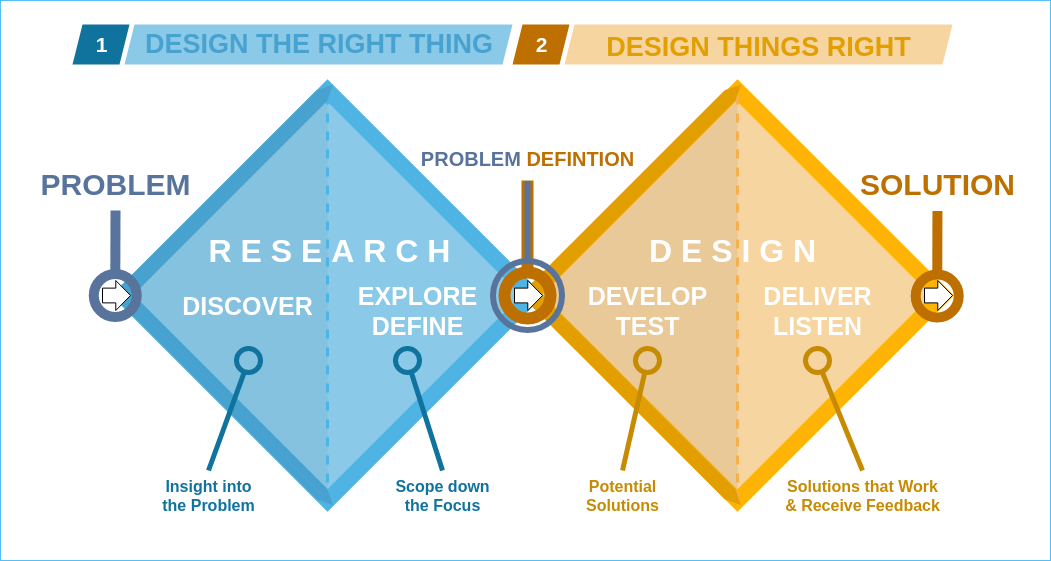
Building Better Products by Mastering Product Discovery
Product discovery is the iterative process of identifying what should be built within a product's lifecycle. This practice ensures that before an item is added to the product backlog, it's been thoroughly vetted and validated as something of value to the users and the business. Rather than being a sporadic activity, product discovery is a constant among high-performing teams, seamlessly integrating with normal product team operations. It is as much about adopting a particular mindset as it is about following a process, requiring an organizational readiness to truly reap its benefits.
Understanding the importance of product discovery hinges on recognizing the frequent disconnect between the ability to produce software and the success rate of products in the market. Despite advances in Agile and DevOps facilitating faster development cycles, many companies continue to struggle with creating successful products, often due to a siloed approach to product development that doesn't adequately focus on building the right things. Product discovery bridges the gap between strategy and operations, allowing teams to align their product efforts with broader business goals and validate ideas through continuous customer engagement and hypothesis testing. It is essential because it empowers teams to make informed decisions about what to build, thereby increasing the chances of product success and innovation in the market. To gain deeper insights and assess your team’s agility, consider taking our Team Agility Advanced Assessment at Lean Agile Intelligence.
Product Discovery
To strategically enhance the process of Product Discovery within agile teams, Lean Agile Intelligence has meticulously outlined a learning journey encompassing four fundamental stages: Developing, Emerging, Adapting, and Optimizing. The forthcoming sections are dedicated to dissecting each stage in depth, providing agile teams with insightful strategies and practical techniques to refine their product discovery processes. This approach is designed to offer a clear and comprehensive path for teams and individuals eager to excel in product discovery, emphasizing the continuous integration of user feedback, market analysis, and hypothesis testing into the fabric of product development. By progressing through these stages, teams are empowered to make data-driven decisions, thereby significantly enhancing the likelihood of product success and fostering a culture of innovation and market responsiveness.
Developing
An agile team “developing” an understanding of the value of Product Discovery and adopting the foundational techniques should focus on the following improvements:
- The What: Time is regularly dedicated to Discovery (i.e., design sprints, spikes, etc.) to explore potential solutions for customer problems
- The How: Agile teams can use Discovery Kanban as part of their normal process to explore potential solutions for customer problems. Discovery Kanban is a system that combines the front-end activities of innovation, such as user experience, design, and research, with the back-end processes of building and deploying products in Agile methodologies. This approach focuses on a continuous loop of learning, where teams aim to understand problems, experiment with solutions, and validate their findings to discern what is effective. It is especially beneficial for startups and teams dealing with digital products that must stay agile and responsive to market demands. Discovery Kanban ensures a balanced focus on generating new ideas while also making the most of existing ones, thus aiding in managing the evolution of a product efficiently. As products grow and evolve, this system helps maintain a cycle of innovation and improvement, which is vital for keeping products up-to-date and competitive in the market.
-
Tips for Getting Started with Discovery Kanban
-
Understand the Phases: Discovery Kanban involves stages like Idea, Explore, and Validate. It's critical to understand each stage and what is required to move an idea through these phases.
-
Define the System: Establish clear definitions for each phase of the discovery process, ensuring everyone understands the flow from idea generation to validation. Create a Definition of Workflow, which can be found in the Kanban Guide.
-
Visualization: Use a Kanban board to visualize the workflow. This should not just be a series of steps but a map of the discovery process, including various activities like customer interviews, prototypes, and market analysis.
-
Set Clear Policies: Define explicit policies for how ideas will be moved, who is responsible for each step, and how decisions are made. This includes setting Work in Progress (WIP) limits to ensure focus and efficiency.
-
Balance Discovery and Delivery: Ensure there is a balance between the discovery and delivery phases. The Discovery Kanban should feed into the Delivery Kanban seamlessly.
-
Collaborative Team Structure: Build cross-functional teams that can handle both discovery and delivery tasks. This reduces hand-offs and accelerates the process.
-
Iterative Learning: Adopt a mindset of iterative learning where the goal is to test assumptions quickly and refine ideas based on feedback and data.
-
Training and Resources: Utilize resources like the Kanban Pocket Guide and training from an official Kanban source like ProKanban.org
-
Use the Right Tools: Invest in good Kanban software that allows easy updates and provides analytics to help you understand flow and identify bottlenecks such as Actionable Agile.
-
Reflect and Adapt: Regularly review how the Discovery Kanban system is working for your team. Adapt the board and processes to ensure they support productive and insightful discovery work.
-
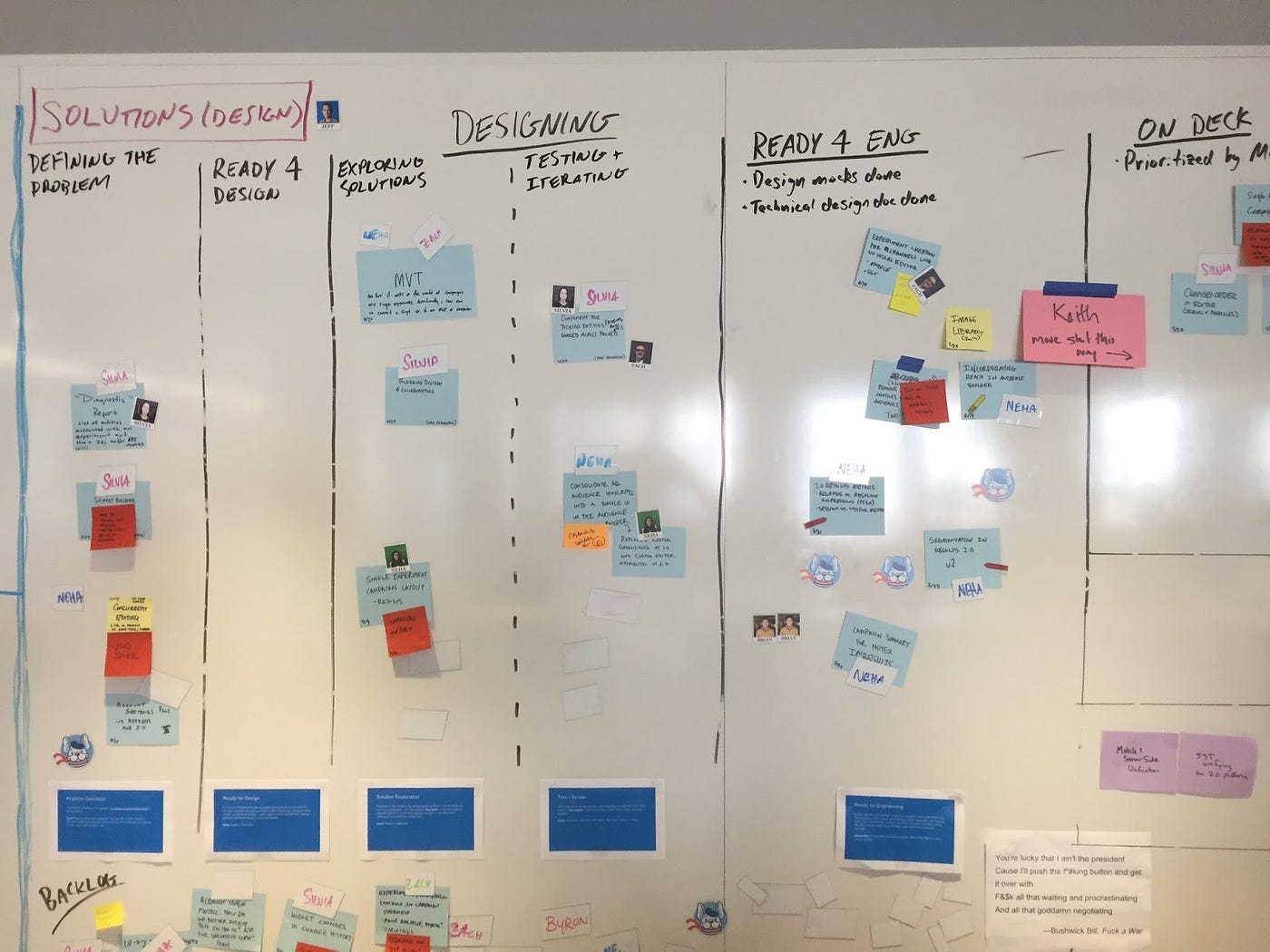
Discovery Kanban Board at Optimizely
- The What: Discovery activities are used to mitigate usability and feasibility risks
- The How: Mitigating usability and feasibility risks is a key part of the product discovery phase. To address these risks, various activities can be employed:
-
User Research: Understanding your users through interviews, surveys, and observation provides insights into their needs and behaviors, which informs usability considerations.
-
When exploring user research techniques, it is important to consider several factors such as research goals, available resources, and product strategy. In product discovery, there are numerous techniques at play, each serving a specific purpose at various stages of the product lifecycle.
One fundamental technique is conducting customer interviews. This approach helps in understanding users' needs, behaviors, and challenges. Unlike methods that produce numbers and charts, interviews provide qualitative insights into the lives of customers. This personal approach allows businesses to capture the lexicon and values of their user base, shaping products that resonate on a deeper level. However, these interviews require time, money, and effort to be invested, making it crucial that each conversation is maximized for value.
Product analytics can be likened to a compass that guides you through the maze of user preferences and behaviors. It provides a quantitative perspective that helps validate the stories and anecdotes gathered from interviews and surveys. Whether you are trying to uncover pain points or fine-tune prototypes, product analytics can help ensure that your decisions are based on solid data rather than mere guesses or hunches.
Competitor analysis reveals the landscape and uncovers opportunities for differentiation. By dissecting rivals’ offerings, companies can position their products more strategically, addressing gaps left wide open by the competition. This ongoing analysis keeps a product relevant and competitive throughout its lifecycle. One technique that can be used for this type of analysis is called "SWAT"
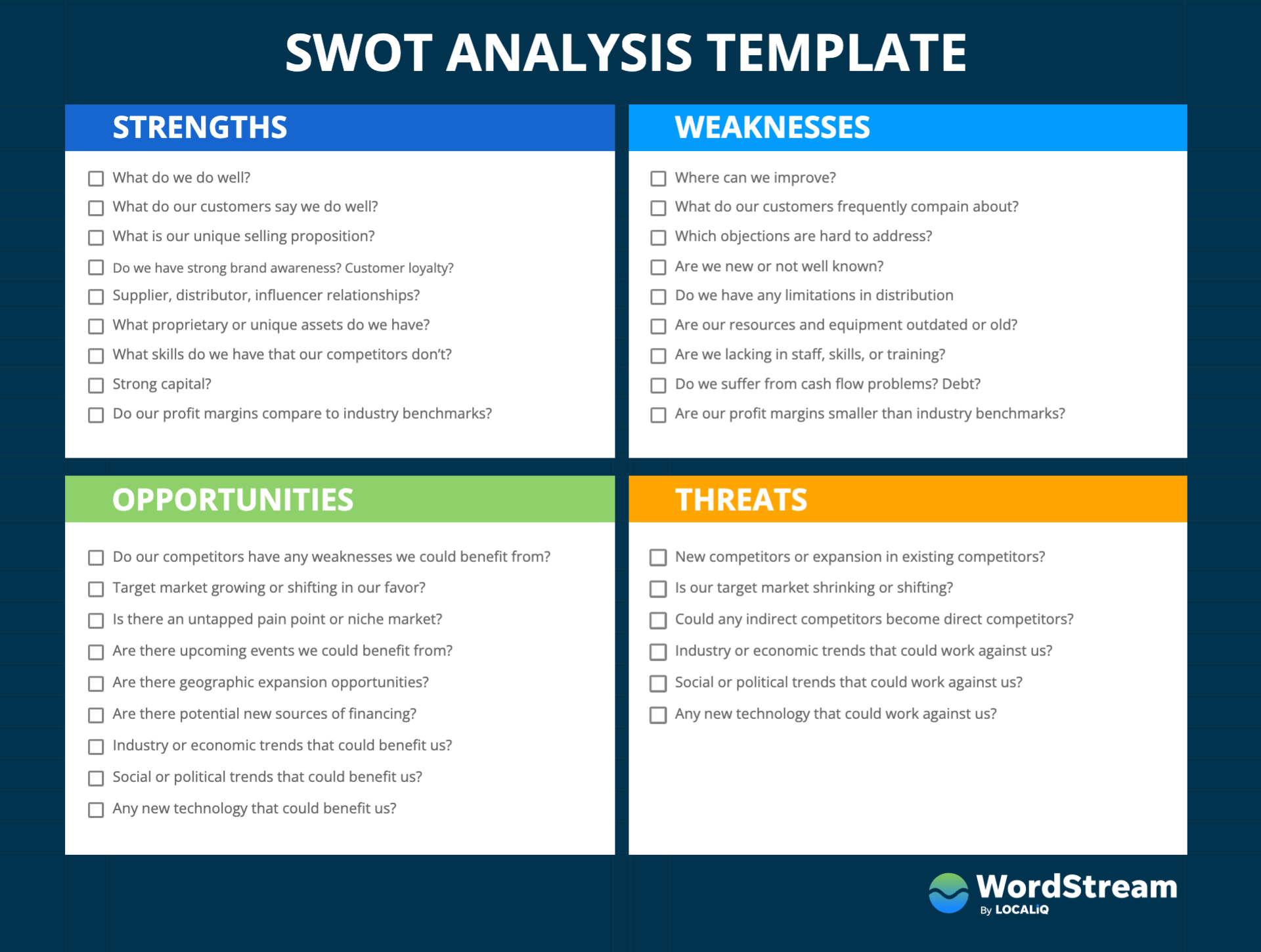 SWOT Analysis Template from WordStream
SWOT Analysis Template from WordStream
The five 'whys' technique is similar to an archaeological dig. With each inquiry, it delves deeper to unearth the underlying issues that need to be addressed. This repetitive questioning helps teams move beyond superficial feature requests and guides them toward transformative solutions that are in line with the core needs of the user. A comment technique for facilitating a five 'whys' session is called a Fishbone Diagram, seen below.
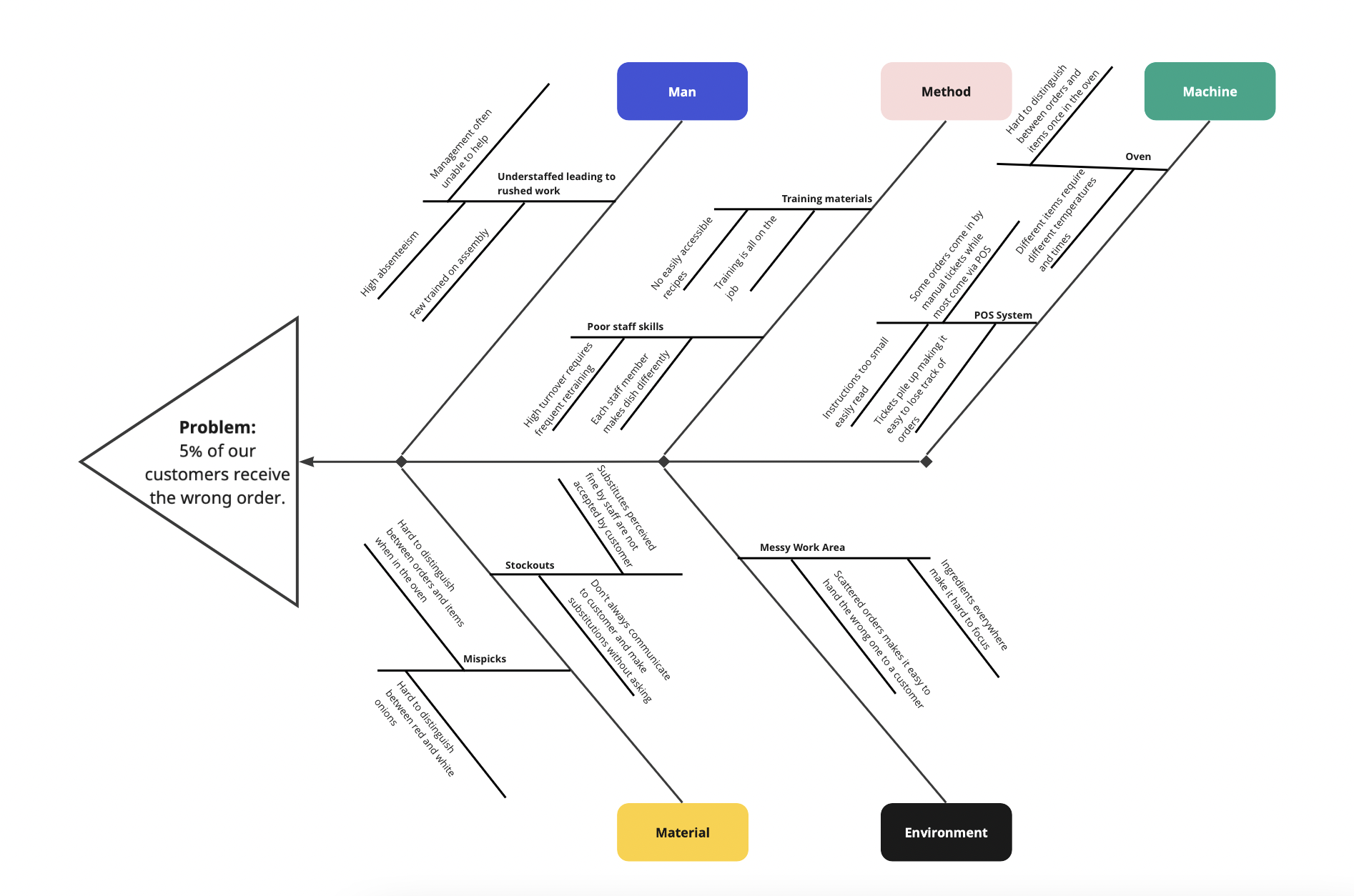
-
-
Persona Development: Creating detailed user personas helps to empathize with target users and can highlight potential usability issues before they arise in development. Here is a template to get started.
-
Usability Testing: Conducting tests with prototypes or existing products allows teams to observe where users encounter problems, informing improvements to usability. Testing with prototypes or existing products is a critical step in the design process, allowing design and development teams to collect valuable feedback on usability issues. Here are some examples of how this can be conducted:
-
Usability Testing Scenario: A tech company has developed a new e-reader prototype and wants to test its usability.
-
Process: Participants are selected who represent the target audience. They are given tasks, such as downloading a book, adjusting the font size, and using the built-in dictionary. Observers note where users struggle or ask questions. A popular tool for Usability Testing can be found here.
-
Outcome: The team may discover users having difficulty finding the dictionary feature. This insight leads to a redesign that makes the feature more accessible and intuitive.
-
-
A/B Testing Scenario: An e-commerce website evaluates two versions of its checkout page to see which one is more user-friendly.
-
Process: Half of the site’s visitors are directed to the current checkout page (A), and the other half to the new version (B). The team tracks metrics like the completion rate and the time taken to purchase. One of the most popular A/B testing tools on the market is Optimizely (which famously practices Discovery Kanban).
-
Outcome: If version B shows a higher completion rate, it suggests that its design is more usable. The team then implements version B for all users.
-
-
Beta Testing Scenario: A video game studio has a complete but unreleased game and wants real-world feedback.
-
Process: A beta version of the game is released to a select group of users likely to be the game’s primary audience. Beta testers are encouraged to report any issues they encounter, from bugs to gameplay mechanics that are not user-friendly.
-
Outcome: The game developers use this feedback to adjust, such as tweaking the difficulty level or fixing a problematic control scheme.
-
-
Focus Groups Scenario: A home appliance manufacturer is considering updates to its line of blenders.
-
Process: A focus group of potential customers is brought together to interact with the different blender models. They are observed and later asked for feedback on their experience, what they liked, and what they found confusing or problematic.
-
Outcome: The manufacturer learns that users want quieter blenders with easier-to-clean parts, informing the next design iteration.
-
-
Field Studies Scenario: A mobile app designed for outdoor hikers must be tested in the intended environment.
- Process: Researchers accompany users on hikes, observing how they interact with the app in various conditions, such as bright sunlight or areas without cellular service.
- Outcome: The insights gained led to improvements, such as increasing the app’s offline capabilities and enhancing screen readability in sunlight.
- Diary Studies Scenario: A fitness tracker company wants to understand how users interact with their devices over time.
- Process: Users are given a prototype fitness tracker and asked to record their experiences and any issues they face over weeks.
- Outcome: The diaries reveal that users often forget to log their meals, leading to the development of a meal-tracking reminder feature.
-
-
- The How: Mitigating usability and feasibility risks is a key part of the product discovery phase. To address these risks, various activities can be employed:
- The What: Product managers, designers, engineering, and whoever else adds value collaboratively work on solution ideas during Discovery activities
- The How: In Agile, collaboration is crucial during the discovery phase. Product managers outline vision and objectives, designers visualize solutions, and engineers bring in the technical perspective. Teams hold collaborative workshops, and quality assurance professionals anticipate potential issues. User experience (UX) researchers bring in insights from user interviews, surveys, or usability tests. Agile teams keep lines of communication open and continuously refine ideas, solutions, and plans through regular stand-ups, sprint planning meetings, and retrospectives. Finally, the team prioritizes the backlog of ideas and solutions based on their value to the user and the business.
Emerging
An agile team “emerging” beyond the understanding of the value of Product Discovery and adopting the foundational techniques should focus on the following improvements:
- The What: High-fidelity prototypes are presented to real users to create learning
- The How: Creating high-fidelity prototypes is a crucial step in the product discovery process, as it allows teams to visualize and test ideas with a level of detail that closely resembles the final product. Here are a few tools that are used for creating high-fidelity prototypes:
-
Sketch: Primarily used for designing interfaces, Sketch is a vector-based tool that is very popular for its simplicity and focus on UI/UX design. With the help of plugins and integrations, it can be used for high-fidelity prototyping as well.
-
Figma: Figma is a web-based UI/UX design tool that enables real-time collaboration. It’s known for its user-friendly interface and robust prototyping features that allow designers to create complex interactions and transitions.
-
Balsamiq Mockups: While Balsamiq is more focused on low-fidelity wireframes, it can be used to create simple high-fidelity prototypes as well, especially for web and desktop applications.
Each of these tools has its own set of strengths and may cater to different aspects of the prototyping process. Teams often choose a tool based on specific project needs, their existing workflow, and the level of fidelity and interactivity they require for their prototypes. The ability to integrate with other tools and facilitate collaboration is also a crucial factor in the decision-making process.
-
- The How: Creating high-fidelity prototypes is a crucial step in the product discovery process, as it allows teams to visualize and test ideas with a level of detail that closely resembles the final product. Here are a few tools that are used for creating high-fidelity prototypes:
- The What: Hypotheses statements are used to express beliefs and assumptions regarding customer problems, potential solutions, and customer outcomes
- The How: Hypothesis statements are an integral part of product discovery and hypothesis-driven development. They help define assumptions that can be tested to learn about customer needs and validate product ideas. Crafting effective hypothesis statements involves being specific and measurable, addressing the problem, solution, and outcome, keeping it testable, focusing on customer actions and behaviors, using quantifiable metrics, keeping it realistic, and iterating and refining the approach.
- When working for a company that develops productivity apps, it's important to have a clear and measurable hypothesis statement. For instance, if you have an idea for a feature that helps users prioritize their tasks more effectively, you need to construct your hypothesis statement in a way that addresses a clear user problem, proposes a solution, sets an expected measurable outcome, and is realistically testable. An example of a non-effective hypothesis statement would be "We believe that by adding a feature that prioritizes tasks, we will improve our app." This statement is too vague and does not specify the problem, the customer, or the expected outcome.
- On the other hand, an effective hypothesis statement would be "We believe that for office workers who struggle with managing their daily tasks, implementing a feature that automatically prioritizes tasks based on deadline and importance will result in a 30% increase in tasks completed on time. We will measure this through user feedback and by analyzing the average number of tasks marked as completed within their deadlines before and after implementing the feature."
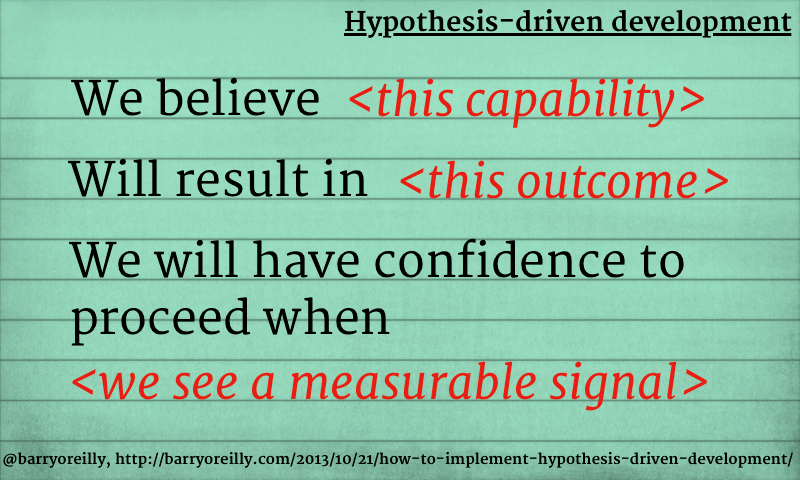
Adapting
An agile team “adapting” beyond the understanding of the value of Product Discovery and adopting the foundational techniques should focus on the following improvements:
- The What: The team validates assumptions/hypotheses by running experiments on real users and measuring the outcome
- The How: When an agile team wants to verify their assumptions or hypotheses with real users, they start by clearly defining what they want to test. This is a crucial step that ensures the hypothesis is specific and measurable. Then, the team selects metrics that will indicate the hypothesis's validity, such as user engagement or conversion rates. They design an experiment, often using A/B testing or a before-and-after study, to observe changes in user behavior. To test the idea and gather genuine user feedback, the team creates a prototype or minimum viable product that is just functional enough. Recruiting participants who are representative of the target audience is critical for collecting data that reflects actual user behavior.
- During the experiment, the team collects data rigorously using tools like analytics platforms and feedback forms. After the experiment, they analyze the data to see if it supports the hypothesis. The findings dictate the following steps: if the hypothesis is confirmed, the team can move forward with more confidence, but if not, they use the learnings to refine their approach. The results are shared with stakeholders, promoting transparency and continuous improvement. Ultimately, the insights gained are incorporated into the product development process, ensuring that each experiment contributes to a more user-centric and effective product. The documentation is maintained meticulously throughout the process, serving as a reference and a record for future reference and learning.
- The How: When an agile team wants to verify their assumptions or hypotheses with real users, they start by clearly defining what they want to test. This is a crucial step that ensures the hypothesis is specific and measurable. Then, the team selects metrics that will indicate the hypothesis's validity, such as user engagement or conversion rates. They design an experiment, often using A/B testing or a before-and-after study, to observe changes in user behavior. To test the idea and gather genuine user feedback, the team creates a prototype or minimum viable product that is just functional enough. Recruiting participants who are representative of the target audience is critical for collecting data that reflects actual user behavior.
- The What: Many ideas have been killed early on as a result of Discovery activities
- The How: In agile teams, failing fast and learning fast is crucial. During the Discovery phase, if there's evidence an idea may not work, halt its progress. Conduct comprehensive exploration by researching the market, interviewing users, prototyping, and doing feasibility studies. If the exploration reveals significant obstacles, such as high costs or low user engagement, discontinue the idea. Document findings and learnings thoroughly to guide future projects. This approach values flexibility and pivoting based on new information.
- The What: The same team members that participated in discovery activities, deliver the solution
- The How: To ensure consistency and quality in product delivery, organizations should create stable cross-functional teams consisting of individuals from various disciplines. Regular communication channels should be maintained throughout the product development lifecycle to foster an environment of learning and feedback. Training and professional development are also crucial to enable team members to contribute effectively in all phases of development Senior leadership should set clear expectations and provide necessary resources to reinforce the practice of having the same individuals see a product development from start to finish.
Optimizing
An agile team “optimizing” beyond the understanding of the value of Product Discovery and adopting the foundational techniques should focus on the following improvements:
- The What: A toolkit of different qualitative and quantitative Discovery techniques exists; which one is used depends on the learning required
- The How: Teams can use various tools for qualitative and quantitative research during discovery activities. Tools are selected based on data requirements and insights needed. Some tools for discovery techniques include...
- Qualitative Discovery Tools:
- User Interviews: Skype, Zoom, Otter.ai, Lookback.io
- Usability Testing: UserTesting, Hotjar, FullStory
- Ethnographic Field Studies: Evernote, Microsoft OneNote, GoPro, Trello
- Focus Groups: Zoom, Microsoft Teams, Mural, Miro
- Design Sprints/Workshops: InVision Freehand, Mural, Miro
- Quantitative Discovery Tools:
- Surveys and Questionnaires: SurveyMonkey, Google Forms, Typeform
- A/B Testing: Optimizely, VWO, Google Optimize
- Web and User Analytics: Google Analytics, Mixpanel
- Behavioral Analytics: Heap, Crazy Egg
- Data Visualization and Reporting: Tableau, Microsoft Power BI
- Qualitative Discovery Tools:
- The How: Teams can use various tools for qualitative and quantitative research during discovery activities. Tools are selected based on data requirements and insights needed. Some tools for discovery techniques include...
The key to successful discovery is integrating these tools into a seamless workflow that supports the team's objectives. This often involves connecting qualitative insights with quantitative data to create a holistic understanding of the user experience and inform product decisions.
* * * * * *
"During the Discovery phase, if there's evidence an idea may not work, halt its progress."
* * * * * *
Conclusion
In conclusion, the pursuit of excellence in Product Discovery is a journey that requires agile teams to not only embrace a set of processes but also to cultivate a mindset geared towards continuous innovation and user-centric development. As teams progress through the stages of Developing, Emerging, Adapting, and Optimizing, they become increasingly adept at aligning their products with the evolving needs of users and the strategic goals of their business. This journey is marked by a relentless focus on learning, testing, and adapting, driven by a commitment to delivering products that truly resonate with users and stand out in the market. For agile teams, mastering Product Discovery is not just about developing new features; it's about fostering a culture of curiosity, collaboration, and customer-focused innovation. This approach not only elevates the chances of product success but also positions teams to be proactive and adaptive in a rapidly changing market landscape. To evaluate your team’s current practices and uncover strategies for improvement, take our Team Agility Advanced Assessment at Lean Agile Intelligence and empower your team to reach new heights in agility.